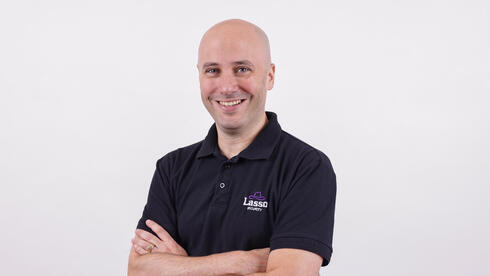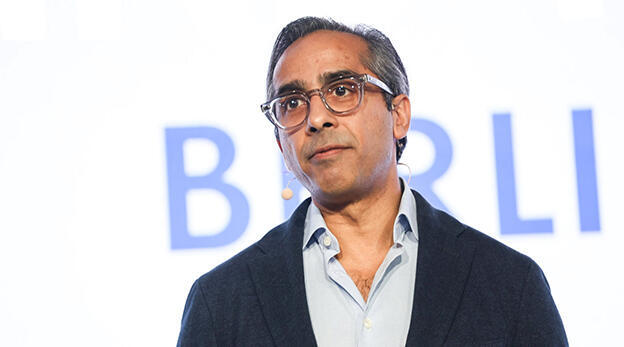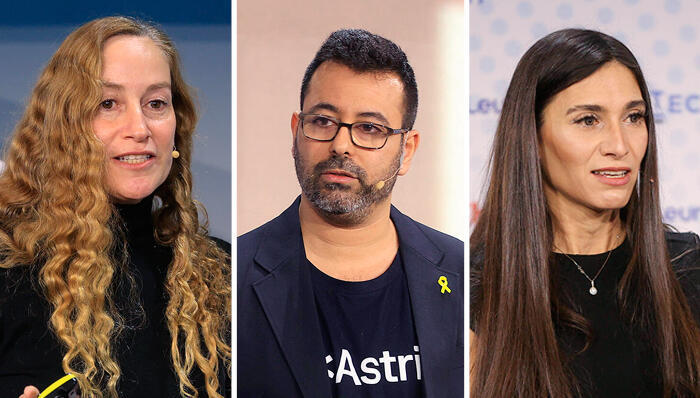
HR in the AI Era
Kaltura’s Adi Hendler says AI hasn’t replaced human labor in the company: “It’s reshaping it”
AI is changing the way Kaltura creates value, makes decisions, and runs its day-to-day. And for HR, the impact goes far beyond efficiency.
“For mid-size tech companies like ours, it’s not just a shift – it’s a leap,” said Adi Hendler, Director, Learning and Development at Kaltura. “AI is helping us reimagine the employee experience from the ground up”.
CTech’s "HR in the AI Era" series explores how the AI revolution is impacting the workforce across Israeli high-tech companies. In this series, we uncover the effects (both personal and professional) that this technology shift has had on Startup Nation.
“Ultimately, this shift isn’t just about tech – it’s cultural. As productivity rises, we’re seeing stronger employee satisfaction and retention,” Hendler added. At the same time, she recognized, “AI tools are beginning to impact junior developer roles, where automation is starting to replace some entry-level tasks.”
You can read the entire interview below.
Company name: Kaltura
Your name and title: Adi Hendler, Director, Learning and Development
Names of founders and upper management: Ron Yekutiel (Co-Founder and CEO), Navi Azaria (Chief Product, Engineering and Marketing Officer), and Sigal Srur (CHRO)
Year of founding: 2006
Investment stage: Public Company
Total investment to date: IPO on Nasdaq in 2021 at a valuation of $1.2 Billion
Field of activity: Agentic AI video solutions for large scale enterprise companies
Number of employees: 700 globally
Office location: Israel (Bnei Brak), NYC, London and Singapore
Number of open positions: 20
On a scale of 1-10, how much does the AI revolution disrupt your company operation in general, and the HR department specifically?
7
How so?
The AI revolution is definitely shaking things up. For mid-size tech companies like ours, it’s not just a shift – it’s a leap. AI is changing the way we create value, make decisions, and run our day-to-day.
We’re seeing a major acceleration in how fast we can bring ideas to life. AI tools have transformed product development – what used to take weeks can now happen in days. Once we embraced AI, we found we could deliver smarter, more cost-effective solutions at speed.
It’s also reshaping operational efficiency. With fewer bottlenecks and smoother workflows, AI automates repetitive tasks and frees people up to focus on higher-value, more creative work. That shift makes a real difference in how scalable and resilient we are as a business.
And as for data – with real-time insights, we can spot trends faster and make sharper decisions, whether it’s predicting market changes or solving business challenges proactively.
In HR, the impact goes far beyond efficiency. AI is helping us reimagine the employee experience from the ground up. From day one, onboarding and learning are becoming more personalized – AI helps us identify skill gaps and tailor development paths to individual needs, supporting continuous growth and upskilling. It’s also helping us become more forward-looking. By shifting away from repetitive tasks, HR is becoming more people-focused and future-ready. We’re streamlining hiring, identifying retention risks early, and reducing bias in key decisions through more objective, data-driven insights.
More broadly, AI is transforming how we approach many of our day-to-day tasks. And that’s opening up space for more innovation, more agility, and more meaningful impact – across the business, and especially in HR.
Ultimately, this shift isn’t just about tech – it’s cultural. As productivity rises, we’re seeing stronger employee satisfaction and retention. AI is helping us evolve HR into a true strategic partner – one that enables the entire organization to adapt, grow, and thrive in an era of rapid transformation.
What interesting AI tools do you and your staff use in employee management/recruitment?
We're officially using Microsoft 365 Co Pilot, Juno Journey's AI capabilities and Growth Space AI capabilities.
In which roles or tasks within your company has AI already begun to replace human labor (if at all)?
AI hasn’t replaced human labor in our company – it’s reshaping it. Rather than focusing on replacement, we’ve prioritized reskilling and upskilling, giving employees the opportunity to grow professionally and shift into roles aligned with the evolving AI landscape.
As business and product needs evolve, we’re seeing employees take on new positions that leverage AI capabilities – whether in operations, product, or customer-facing roles. This internal mobility reflects an agile organization that’s reorganizing itself from within to meet emerging demands.
Mastering AI tools is enabling our teams to boost productivity, become more agile, and reimagine their roles with greater creativity and impact. As a result, we’re seeing higher satisfaction, deeper engagement, and stronger retention across the board. We do, however, recognize that AI tools are beginning to impact junior developer roles, where automation is starting to replace some entry-level tasks.
What are the two major challenges you are coping with these days?
One of the biggest challenges we’re facing right now is building AI literacy across the entire organization – both technically and emotionally. As AI becomes embedded in more workflows, it’s not just the HR team that needs to learn how to work alongside it – it’s everyone. We’re focused on helping employees at all levels develop the skills to use AI tools effectively, understand data-driven insights, and make confident, informed decisions. At the same time, we’re addressing the emotional side of this transformation: the uncertainty, the fear of job displacement, and the cultural shift that comes with change. It’s a delicate balance between upskilling and reassuring, and it requires open communication, ongoing learning opportunities, and a strong support system.
The second major challenge is more strategic and infrastructure-focused: selecting, securing, and successfully implementing the right AI tools. With so many new platforms and capabilities emerging, the pressure to “choose right” is high. We’re evaluating tools not just for their features, but for how well they integrate with our systems, protect employee data, and support long-term business goals. Knowledge management is also key – ensuring that what we build with AI doesn’t just solve short-term problems but contributes to a smarter, more connected organization. And like any tech investment, it’s about smart prioritization: where AI will truly drive value, how we measure ROI, and how we roll it out in a way that’s scalable, secure, and sustainable.
Have you experienced workforce-related challenges due to the war, and are you still feeling the impact of the security situation on your human resources?
Yes, we have experienced workforce-related challenges due to the war – particularly in Israel, where during the first six months, nearly 10% of our local workforce was called to reserve duty. Many of our employees also had close family members directly impacted.
We also stood by employees and families who were directly affected by the October 7th atrocities, offering them all the support they needed – physically, mentally, and emotionally. We gave them the space to heal, both individually and within the company, with ongoing care from their managers and the support of colleagues and friends.
In response to the broader situation in Israel, we launched a dedicated support program for impacted employees and their families, and for reserved duty employees and families – providing operational flexibility, mental health resources, and tailored assistance where needed. We also gave all employees the opportunity to get involved: from volunteering and contributing to community efforts, to donating in support of the hostages and other humanitarian causes.
Throughout this time, we've continued to handle every situation with deep sensitivity, always mindful of the cultural differences across our global locations. Importantly, we maintain a clear policy of not allowing political discourse in formal company settings. Our focus remains on unity, humanity, and taking care of one another. From the very beginning, we’ve pledged to stand for a pluralistic and diverse society – and we carry that commitment into every part of our culture. We work actively to ensure that every employee feels respected, supported, and a true sense of belonging – no matter where they are or what they may be going through.
Have you made changes to your workforce following the increased use of AI tools, both in terms of headcount and internal shifts between departments?
Up until now, we’re not seeing dramatic changes in headcount due to AI, but we are seeing internal shifts in focus and structure. Almost every division is adding AI capabilities, and we’ve appointed AI leaders – employees who took on this responsibility in addition to their existing roles and titles. It’s not just about hiring AI experts; it’s about growing them from within.
In fact, many of our R&D and Product team members are evolving into in-house AI experts.
We’re actively equipping them with the skills, training, and knowledge needed to lead us into the AI era – translating technical growth into business capabilities and product advantage. This inside-out approach ensures we stay agile, relevant, and deeply connected to our core expertise.
We were also among the first to identify the need for a VP Corporate AI – a role now embedded in our HR leadership team to bridge HR, IT, and business strategy. This ensures that AI implementation is not only innovative but also responsible, ethical, and aligned with organizational goals. We’ve deepened collaboration between HR and IT to accelerate AI adoption, and appointed AI leads in each department to support localized, hands-on integration. This structure enables faster adaptation, tailored experiences per division, and stronger alignment with HR.
We do, however, recognize that AI tools are beginning to impact junior developer roles, where automation is starting to replace some entry-level tasks. Also, our L&OD function is prioritizing large-scale reskilling and upskilling, especially in digital, analytical, and emotional intelligence (EI) skills. These efforts are opening up new opportunities, increasing internal mobility, and reinforcing roles where human strengths – like empathy, creativity, and complex problem-solving – complement AI’s capabilities.
How does the global market uncertainty affect your workforce, in terms of employee numbers or departmental reallocations? Are you scaling your workforce up or down in different regions around the world?
At the moment, we’re not planning any changes in headcount or reallocations of employees across regions. That said, the current global uncertainty is pushing us to stay agile – especially in how we approach our strategic and product roadmaps. Rather than responding with workforce shifts, we’re focused on accelerating innovation and developing advanced AI solutions that can bring greater value to our customers.
This environment reinforces the importance of flexibility, both in mindset and in operations. Our efforts are geared toward empowering existing teams with the tools, skills, and adaptability needed to navigate change, rather than restructuring the workforce.
Do you estimate that in 2025–2026 you will increase or decrease the number of personnel? Explain why.
At the moment, we don’t forecast any dramatic changes in headcount for 2025–2026. While we remain agile and responsive to market shifts, our focus is on strengthening internal capabilities – particularly through upskilling, cross-functional collaboration, and integrating AI where it brings real value. Rather than expanding or reducing dramatically, we're investing in making our existing workforce more adaptive, empowered, and aligned with evolving business needs.
What is your bottom line on this topic?
As AI becomes part of our day-to-day, we’re helping our people upskill, shift roles, and step into new opportunities. We’ve seen teams become more agile, more connected, and even more creative. It’s less about replacing jobs and more about reimagining them – together. And through it all, we’re staying true to our values: supporting each other, staying inclusive, and making sure everyone feels they belong.













